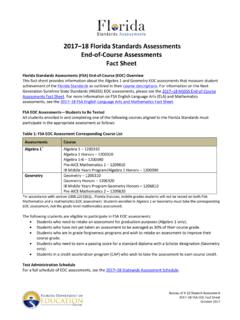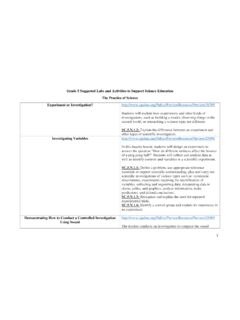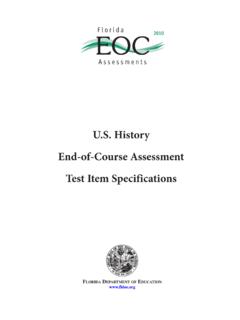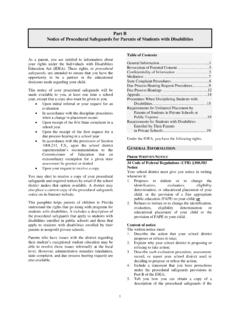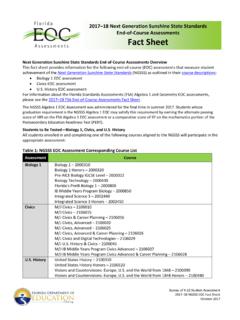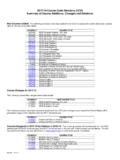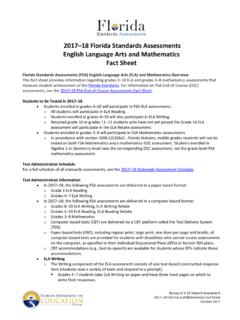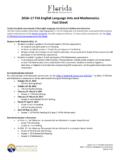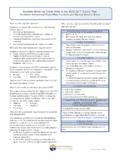Transcription of Mathematics Florida Standards (MAFS) Grade 4
1 Mathematics Florida Standards (MAFS). Grade 4. Domain: OPERATIONS AND ALGEBRAIC THINKING. Cluster 1: Use the four operations with whole numbers to solve problems. (Major Cluster). Don't sort clusters from Major to Supporting, and then teach them in that order. To do so would strip the coherence of the mathematical ideas and miss the opportunity to enhance the major work of the Grade with the supporting clusters. STANDARD CODE STANDARD. Interpret a multiplication equation as a comparison, , interpret 35 = 5 7. as a statement that 35 is 5 times as many as 7 and 7 times as many as 5.
2 Represent verbal statements of multiplicative comparisons as multiplication equations. Cognitive Complexity: Level 1: Recall Multiply or divide to solve word problems involving multiplicative comparison, , by using drawings and equations with a symbol for the unknown number to represent the problem, distinguishing multiplicative comparison from additive comparison. Cognitive Complexity: Level 2: Basic Application of Skills & Concepts Solve multistep word problems posed with whole numbers and having whole- number answers using the four operations, including problems in which remainders must be interpreted.
3 Represent these problems using equations with a letter standing for the unknown quantity. Assess the reasonableness of answers using mental computation and estimation strategies including rounding. Cognitive Complexity: Level 2: Basic Application of Skills & Concepts Determine whether an equation is true or false by using comparative relational thinking. For example, without adding 60 and 24, determine whether the equation 60 + 24 = 57 + 27 is true or false. Determine the unknown whole number in an equation relating four whole numbers using comparative relational thinking. For example, solve 76 + 9 = n +.
4 5 for n by arguing that nine is four more than five, so the unknown number must be four greater than 76. | #FLStandards 2014, Florida Department of Education. All Rights Reserved. Cluster 2: Gain familiarity with factors and multiples. (Supporting Cluster). Don't sort clusters from Major to Supporting, and then teach them in that order. To do so would strip the coherence of the mathematical ideas and miss the opportunity to enhance the major work of the Grade with the supporting clusters. STANDARD CODE STANDARD. Investigate factors and multiples. a. Find all factor pairs for a whole number in the range 1 100.
5 B. Recognize that a whole number is a multiple of each of its factors. Determine whether a given whole number in the range 1 100 is a multiple of a given one-digit number. c. Determine whether a given whole number in the range 1 100 is prime or composite. Cognitive Complexity: Level 2: Basic Application of Skills & Concepts Cluster 3: Generate and analyze patterns. (Additional Cluster). Don't sort clusters from Major to Supporting, and then teach them in that order. To do so would strip the coherence of the mathematical ideas and miss the opportunity to enhance the major work of the Grade with the supporting clusters.
6 STANDARD CODE STANDARD. Generate a number or shape pattern that follows a given rule. Identify apparent features of the pattern that were not explicit in the rule itself. For example, given the rule Add 3 and the starting number 1, generate terms in the resulting sequence and observe that the terms appear to alternate between odd and even numbers. Explain informally why the numbers will continue to alternate in this way. Cognitive Complexity: Level 2: Basic Application of Skills & Concepts Domain: NUMBER AND OPERATIONS IN BASE TEN. Cluster 1: Generalize place value understanding for multi-digit whole numbers.
7 (Major Cluster). Don't sort clusters from Major to Supporting, and then teach them in that order. To do so would strip the coherence of the mathematical ideas and miss the opportunity to enhance the major work of the Grade with the supporting clusters. STANDARD CODE STANDARD. Recognize that in a multi-digit whole number, a digit in one place represents ten times what it represents in the place to its right. For example, recognize that 700 70 = 10 by applying concepts of place value and division. Cognitive Complexity: Level 1: Recall Read and write multi-digit whole numbers using base-ten numerals, number | #FLStandards 2014, Florida Department of Education.
8 All Rights Reserved. names, and expanded form. Compare two multi-digit numbers based on meanings of the digits in each place, using >, =, and < symbols to record the results of comparisons. Cognitive Complexity: Level 2: Basic Application of Skills & Concepts Use place value understanding to round multi-digit whole numbers to any place. Cognitive Complexity: Level 1: Recall Cluster 2: Use place value understanding and properties of operations to perform multi-digit arithmetic. (Major Cluster). Don't sort clusters from Major to Supporting, and then teach them in that order. To do so would strip the coherence of the mathematical ideas and miss the opportunity to enhance the major work of the Grade with the supporting clusters.
9 STANDARD CODE STANDARD. Fluently add and subtract multi-digit whole numbers using the standard algorithm. Cognitive Complexity: Level 1: Recall Multiply a whole number of up to four digits by a one-digit whole number, and multiply two two-digit numbers, using strategies based on place value and the properties of operations. Illustrate and explain the calculation by using equations, rectangular arrays, and/or area models. Cognitive Complexity: Level 2: Basic Application of Skills & Concepts Find whole-number quotients and remainders with up to four-digit dividends and one-digit divisors, using strategies based on place value, the properties of operations, and/or the relationship between multiplication and division.
10 Illustrate and explain the calculation by using equations, rectangular arrays, and/or area models. Cognitive Complexity: Level 2: Basic Application of Skills & Concepts Domain: NUMBER AND OPERATIONS fractions . Cluster 1: Extend understanding of fraction equivalence and ordering. (Major Cluster). Don't sort clusters from Major to Supporting, and then teach them in that order. To do so would strip the coherence of the mathematical ideas and miss the opportunity to enhance the major work of the Grade with the supporting clusters. STANDARD CODE STANDARD. Explain why a fraction a/b is equivalent to a fraction (n a)/(n b) by using visual fraction models, with attention to how the number and size of the parts differ even though the two fractions themselves are the same size.
